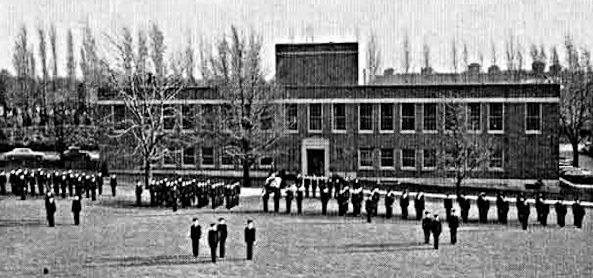
| River Campus | Harkness Hall |
 |
| Harkness
Hall in 1955 |
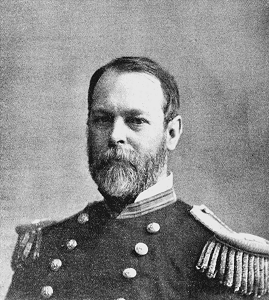 |
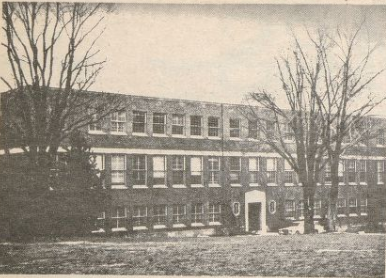 |
| Admiral William Harkness | Harkness Hall in 1963 with new third floor |
| Pictures from the NROTC Armory in Harness Hall | ||
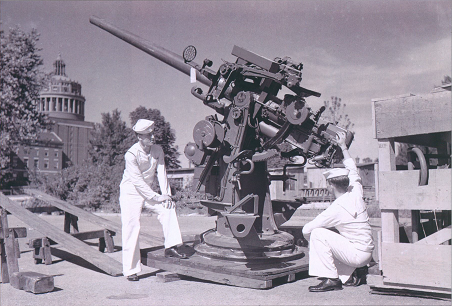 |
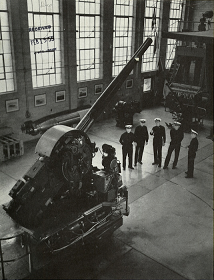 |
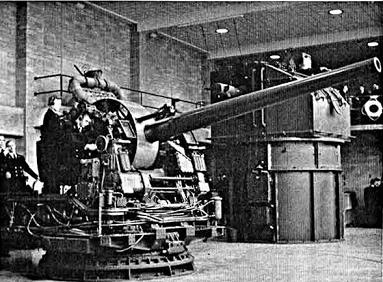 |
 |
 |
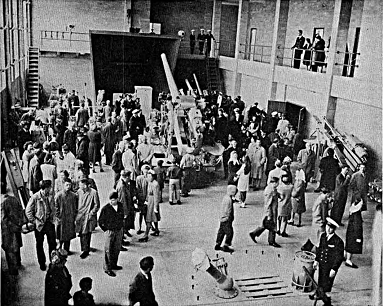 |
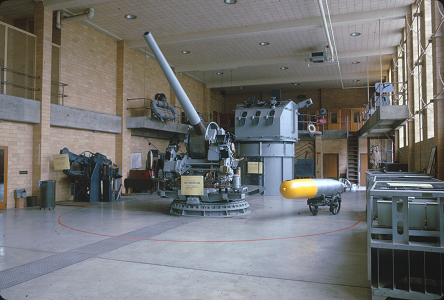 |
The University explored hosting military training in 1862 at the request of the Regents of the State University, but nothing came of it. Many students enlisted in the Army, including William C. Morey.
During World War I the University participated in the Student Army Training Corps, which began operating on campus on October 1, 1918. Sixty soldiers were housed in Kendrick Hall and another ninety-two in a temporary wooden barracks. The program was discontinued after the Armistice on November 11th and the barracks was torn down and sold for scrap. Colleges participating in S.A.T.C were given the opportunity to apply for a new Reserve Office Training Corps program, but the University administration felt that "We do not at present see how, in times of peace, military training and academic work can be carried on simultaneously with advantage.".
A proposal to develop an ROTC program on campus was suggested in 1935, but did not secure much support.
The onset of World War II resulted in a large demand for Navy and Marine Corps officers, and the V-12 Navy College Training Program was developed in December 1942. The Army had a similar program, but the Navy was preferable for many colleges as it allowed V-12 students to attend classes with civilian students and also participate in athletics. Programs were established at 131 colleges, most of which were smaller, private institutions. The program began on July 1, 1943 and the students were housed in Burton, Crosby, Alumni Gym, Fauver Stadium, and fraternity houses. Enrollment reached a peak of 640 in mid-1944, after which the program began to wind down. As was the case in World War I, institutions were given the opportunity to host a Navy ROTC unit, and this time the University became one of 25 campuses that were approved to host Navy Reserve Officer Training Corps units in 1945.
The NROTC program began in September 1945 and a dedicated building was opened in June 1946 and named after Admiral William Harkness, a well-known Navy astronomer who was an 1858 graduate of the University. The building was the first such building on a civilian campus. The two-story building housed classrooms, offices, a Naval library, a target range, and a two-story armory on the south side with ten high windows. The armory equipment included a Mark 12 5"/38 caliber gun with a dual-purpose mount, a Mark 37 gun director, and a navigational bridge.
In 1953 the University hired noted photographer Ansel Adams to take pictures of the campus for a promotional book. One picture was of the 5-inch gun in the Harkness armory (middle picture in the top row above).
An Air Force ROTC program was established in 1951 in basement of Rush Rhees Library where the Art & Music Library is now located. The reunion of the colleges in 1955 resulted in the Air Force program also moving into Harkness.
The removal of the obsolete 5-inch gun in September 1961 allowed the University to remodel the building by dividing the armory space into two floors and adding a third floor. The ten high windows can still be seen on the south side of the building, with panels installed where the new floor was built.
The Vietnam era saw a lot of anti-war protests on American college campuses and anger was often directed to campus ROTC programs. Some faculty in Harkness took their research home every night due to their fear that the building would be burned, as some ROTC buildings were after the Cambodia incursion and Kent State shootings in May 1970. Declining enrollment during the Vietnam era led to the discontinuance of the Air Force ROTC Program on campus in 1970, and declining Navy enrollments resulted in the Navy ROTC moving to Fauver Stadium in the Fall of 1970. The program then moved to Morey Hall in the Fall of 1975 and from there to Todd Union before moving back to Morey in 1987.
References
1862 Report of the Regents of the
University on Military Instruction in the College and Higher
Institutions of Learning, in the State, in Response to the Resolution
of the Assembly of January 24th, 1862. March 7, 1862.
Pages 16-19: University of Rochester
1862 "Military Instruction in Colleges - The University of Rochester," Rochester Union & Advertiser, March 26, 1862, Page 2.
1885 Historical
and Statistical Record of the University of the State of New York:
During the Century from 1784 to 1884, by Franklin Benjamin
Hough
Pages 433-438: Military Instruction in Academies
1903 Adm William Harkness (1837-1903) Grave in Fishkill Road Cemetery, Fishkill, Dutchess County, New York
1903 "Astronomer Harkness Dead, Retired Rear Admiral of the United States, Who Had Charge of the Observatory in Washington," The New York Times, March 1, 1903, Page 7.
1903 "William Harkness. 1837–1903," by R. S. Woodward, Proceedings of the Washington Academy of Sciences 5:381-383 (1903)
1913 "Military
Training Camps for College Students," Buffalo Commercial,
April 21, 1913, Page 1.
Gettysburg, Pennsylvania and Presidio of Monterey, California.
1914 "Uncle
Sam Plans Two More Camps," The Campus, May 12, 1914, Page 5
Rochester Men to be Sent to One of Military Instruction Camps at
Burlington, Vermont or Monterey, California
1914 "Uncle
Sam Training Students in Science of War," Buffalo Sunday Morning
News, August 15, 1914, Page 17.
Burlington, Vermont
1915 "Rochester Men at Student Army Camp," The Campus, January 21, 1915, Page 1 | Part 2 |
1915 "Students
Respond to Military Call," The Campus, May 6, 1915, Page 1 |
Part
2 |
Rochester First College to Form Voluntary Organization
1916 "Plattsburg Boosted," The Campus, May 11, 1916, Page 3
1916 "Sixteen Rochester Men Attend Various Encampments at Plattsburgh," The Campus, September 21, 1916, Page 2
1916 "Typhoid
Fever Inoculation Holds No Pleasure," The Campus, November
16, 1916, Page 2
Live at Plattsburgh Camp
1919 "University of Rochester in the World War," by President Rush Rhees, from Report of the President to the Board of Trustees, June 5, 1919
1935 "Proposal of University ROTC Unit Draws Censure and Commendation," The Campus, May 10, 1935, Page 3
1935 "An ROTC Unit At Rochester?" The Campus, May 10, 1935, Page 6
1937 "Centenary of William Harkness, 1837–1903," Nature 140: 1004 (1937)
1942-1945 Newsletter to University of Rochester Men in the Service
1944 "Civilians to get Campus Rooms," Democrat and Chronicle, September 23, 1944, Page 10.
1945 "Rochester Selected for Naval ROTC Unit," The Campus, May 4, 1945, Page 1.
1945 "329
Enrolled Under NROTC, Naval Science Department Begins," Rochester
Review 23(6):15 (November-December 1945)
Quietly and without ceremony, the Men's College underwent a major change
with the beginning of the November term.
That occasion marked the full-scale introduction of the Naval Reserve
Officers' Training Corps unit at the River Campus, the first military
organization at the University during peacetime since its founding.
There are 329 students in the NROTC, all formerly in the Navy V -12. Of
these, 212 are men who were previously in V-12 at the Men's College, and
the others are transfers from V-12 units at Colgate, Bucknell, Middlebury,
Trinity, and Stevens Institute. In addition, there are 33 V -12 engineers
who are remaining to finish their eight terms, and 18 V-12 students at the
Medical School, for a total of 380 Navy students in the University.
The Rochester NROTC unit is one of 52 in colleges and universities
throughout the country, and is one of 27 new units authorized by the Navy
Department some months ago.
The University has set up a new Department of Naval Science, headed by
Capt. George C. Towner, USN, as professor of naval science. On Captain
Towner's staff are 12 officers, ranging from lieutenants (j. g. ) to
commander, and about 20 enlisted men. Six of the officers are instructors
in naval science and tactics. Others include instructors in gunnery,
supply officers, disbursing personnel, drill officers, and so on.
Work is being rushed on the new naval science building near the
Engineering Building to have it completed early in 1946. It will contain
an armory, shooting gallery, classrooms, offices and other facilities for
the naval students and staff. A five-inch gun and a three-inch gun to be
placed in the armory already have arrived on the campus, along with
quantities of other ordnance with an estimated value of around a million
dollars.
The normal size of the NROTC unit will be about 300. The present set-up,
under which the trainees receive tuition and monthly base pay, will
continue until next July. What changes will be made then will be
determined by Congressional action.
Some hint of what the Navy Department has in mind was given in recent news
reports on a far-reaching plan to educate thousands of officers for the
powerful post-war Navy which has been approved by Navy Secretary
Forrestal. Legislation to carry it out was expected to be introduced
shortly.
The plan calls for putting officer procurement on as broad a base as
possible, drawing candidates from the Naval Academy, Naval Reserve
Officers' Training Corps colleges and other accredited institution.,. It
would double the present output of the Naval Academy, although overall,
the post-war Navy officers' strength would comprise not more than 50 per
cent academy graduates, Navy officials said.
1946 "UR to Name New Hall for Adm. Harkness," Democrat and Chronicle, February 6, 1946, Page 15.
1946 "Naval
Dignitaries to be present at Dedication of Harkness Hall, The
Campus, May 10, 1946, Page 4.
High-ranking representatives the U. S. Navy Department will come to the
University of Rochester on Saturday, June 1, for the dedication of the
University's new naval science building on the River Campus.
The building will be named Harkness Hall in memory of Rear Admiral William
Harkness, USN, a graduate of the University in the class of 1858 who
served as astronomical director of the U. S. Naval Observatory and was an
international authority on naval astronomy. A plaque paying tribute to him
will be placed in the building.
The edifice is said to be the first of its kind to be built at any of the
colleges and universities throughout the country designated as NROTC
center to provide officers for the peacetime U.S. Navy, and the occasion
will serve to introduce the Navy's program to encourage college students
to enroll in the NROTC.
Officers of other NROTC units in the Third Naval District, which includes
Yale, Princeton, Columbia, Cornell and Rensselaer, and of the District
headquarters in New York City also have been invited to attend the
dedication.
A review will be staged by the Rochester unit and its band for the
visiting dignitaries in exercises in Eastman Quadrangle at the River
Campus preceding the dedication address at Harkness Hall.
The public is invited to attend, snd open house will be conducted in
Harkness Hall following the rites to permit inspection of the building and
its facilities for instruction in naval science and tactics.
Ordnance equipment will include a navigational bridge, a five-inch .38
caliber dual purpose surface and anti-aircraft gun, many other pieces in
the armory.
The building also houses classrooms for naval instruction, small stores
room, offices for instructors, a target range, and a Naval reference
library.
George C. Towner, USN, is professor of naval science and tactics for the
Rochester NROTC and Comdr. Wendell H. Froling, USN, is executive officer.
1946 "Navy
Praises New UR Hall in Dedication," Democrat and Chronicle,
June 2, 1946, Page 1B | Part
2 |
Only the scheduled drone of planes overhead was missing as
smartly-uniformed NROTC and V-12 students, their band, color guard, honor
guard and side boys, along with staff and visiting officers, formed in the
Eastman Quadrangle at precisely 2 p. m. to wait the arrival of the
visiting dignitaries. A heavy overcast, providing a ceiling of only 800
feet, prevented the squadron, of 24 Navy bomber fighters from staging the
half-hour exhibition of intricate maneuvers that had been planned over the
campus.
1946 "Asst. Sec. of Navy Dedicates Harkness Hall," The Campus, June 7, 1946, Page 1. | Part 2 |
1946 "'Navy at Rochester to Stay,' says Admiral in Dedicating University's Harkness Hall," Rochester Review 23(9):16-17 (June-July 1946)
1951 "UR to apply for Air Fortc ROTC if student vote approves plan," The Campus, March 2, 1951, Page 1 | Part 2 |
1951 "U of R Selected to be AFROTC Training Center," Campus Times, April 27, 1951, Page 1 | Part 2 |
1951 "154 Join AFROTC for 4-year Course," Campus Times, September 28, 1951, Page 2.
1952 "Air and Navy ROTC Units Play Large Part on Campus," The Campus, September 26, 1952, Page 1 | Part 2 |
1953 Creative
Change – for the University Rochester and the Community, Text
by Andrew D. Wolf, Photography by Ansel Adams.
Page 19: Picture of 5-inch gun in
Harkness Hall.
1955 "Officer Training Now Regarded as Integral Part of College Life," Rochester Review 16(3):12 (January 1955) | Cover |
1955 "ROTC Brings Both Benefits, Educational Problems," by Dr. J. Edward Hoffmeister, Dean of the College of Arts and Science, Rochester Review 16(3):13-15 (January 1955) | Cover |
1955 "Moving
Nears Close; Began Last April 7," Campus Times, November 15,
1955, Page 2.
Material needed by the fine arts classes of the Arts College was moved
from Memorial Art Gallery into space vacated by the ARROTC unit in Rush
Rhee Library. In Harkness Hall, the NROTC offices had to move into
other quarters in that building to make room for the AFROTC staff which
was shifted from the basement of Rush Rhees.
1955 "Air Force ROTC Unit to Disband; Economy Move Closes UR Program," Campus Times, December 9, 1955, Page 1.
1955 "Students Offer Comment on ROTC Disbandment," Campus Times, December 13, 1955, Page 1 | Part 2 |
1956 "Air ROTC Remains," Rochester Review 17(4):7 (March 1956)
1957 "Color Girl Spices ROTC Ceremony," Campus Times, May 3, 1957, Page 3.
1961 "UR Exchanges Big Navy gun for Class Space," Democrat and Chronicle, September 1, 1961, Page 16.
1962 "$665,000 Expansion for Harkness Hall," University Record. 2(2):1 (February 1962)
1962 "UR
to Renovate Harkness to Add Offices, Classrooms," Campus Times,
February 20, 1962, Page 2.
The UR this spring will undertake a $665,000 remodeling and expansion
project at Harkness Hall, naval and air science building on the River
Campus, Dr. McCrea Hazlett, University Provost, announced last week.
The project, which has been in the planning stage since the fall of 1960,
will include major renovation of the two-story building and addition of a
third story.
Dr. Hazlett said that the new Harkness Hall facilities will help to meet
the need for additional classrooms and offices for the University's
expanding programs in anthropology and sociology, economics, and political
science, and will make it possible for the first time to house these
related departments in the same building. Dr. Hazlett noted that
facilities for the social sciences are among the high priority needs of
the $9.9 million Greater University Program initiated in the fall of 1959
to meet the University's requirements as projected through 1965.
The new areas of the building are expected to be ready for occupancy next
fall, Dr. Hazlett stated. The Hall will continue to house the
University's Navy and Air Force ROTC units.
Navy Gun Removed
Dr. Hazlett explained that renovation of Harkness Hall was made possible
by the removal of an outmoded World War II gun which, until this fall, had
occupied a two-story area of the building known as the Armory. The gun,
which was no longer needed for the University's naval science program, was
removed by the Navy last September.
According to Roger Austin, the University's architect, some 4,000 square
feet of the first floor of the former Armory will be converted into
classroom space for the Naval and Air Force Reserve Training programs and
for general University use, and will also provide service and storage
facilities for the air and naval units. The remaining first-floor area
will continue to be used for offices by the Naval and Air Force ROTC
units.
The addition of some 4,000 square feet of floor space to the upper area of
the former Armory will provide undergraduate classrooms, seminar rooms,
faculty offices, and graduate student rooms for the Department of
Economics.
Third Floor
The new third floor, providing some 12,000 square feet of floor area, will
house undergraduate classrooms, seminar rooms, faculty and graduate
student offices, laboratory and conference facilities for the Department
of Anthropology and Sociology and the Department of Political Science.
Austin said that working drawings for the project will be made by
Waasdorp, Northrup and Kaelbee.
Completed in 1946, Harkness Hall at that time was the first building of
its kind (except for the United States Naval Academy at Annapolis) devoted
entirely to naval science and tactics.
1962 Rochester
Review 24(3):16 (February-March 1962)
Harkness Hall, long devoted to the military sciences, will assume a
partially civilian air next fall following extensive remodeling and
expansion of the two-story building.
Renovation of the hall will provide needed space for additional classrooms
and offices for the University's expanding programs in anthropology and
sociology, economics, and political science, and will, for the first time,
permit these related departments to be housed in the same building. The
Navy and Air Force ROTC units will continue to use the hall.
The $665,000 remodeling project will include the addition of a third story
and renovation of a two-story area within the building formerly occupied
by an outmoded gun no longer needed in the naval science program.
1966 "NROTC
Program Added at UR," Democrat and Chronicle, March 7, 1966,
Page 4C.
University of Rochester's department of naval science has added a two-year
contract Naval Reserve Officers Training Corps program leading to a
reserved commission in the Navy or Marine Corps. Students in the program
are classified as students taking military training. Prior to the junior
year those in the advanced program will take six weeks of training at a
university. Costs plus a stipend are paid during the study of naval
history and weapons. Obligation after commissioning is three years active
duty.
1967 "NROTC
Dedicates Wardroom to King," Campus Times, November 17,
1967, Page 1 | Part
2 |
2nd Lt. Thomas G. King, USMC, Class of 1966, died in action in Viet Nam on
July 2, 1967.
1969 "Contract Plan Aids UR AFROTC; NROTC in Downward Trend," Campus Times, January 17, 1969, Page 2.
1969 "Colleges
to Decide on ROTC," Democrat and Chronicle, August 2, 1969,
Page 2B.
86-page report released yesterday.
1970 "UR
to Drop Air Force ROTC," Campus Times, March 24, 1970, Page
1
Two-year training course for upperclassmen presently has only nine seniors
and eight juniors, and nine of these seventeen cadets are St. John Fisher
college students.
1970 "Thompson
Announces Revised Construction Schedule for Major Building and
Renovation Projects," Currents, October 15, 1970.
Renovation of areas of Fauver Stadium for the Dept. of Fine Arts and for
NROTC--to be completed in November, 1970.
1973 "NROTC Enrollment Rises," Campus Times, February 14, 1973, Page 1 | Part 2 |
1974 "NROTC
Interest Increases," Campus Times, November 7, 1974, Page 1
| Part
2 |
The University of Rochester will commission its first woman this May.
1975 "UR
May Raze Morey Annex This Summer," Campus Times, April 15,
1975, Page 1. | Page
2 |
First and second floors of Morey are empty
1975 "Energy
Cuts Generate Savings," Campus Times, September 16, 1975,
Page 1.
As part of this program, Fauver Stadium is being vacated, with the Naval
Science department moving to Morey.
1976 "Student Acceptance Achieved by ROTC," Campus Times, February 5, 1976, Page 6
1977 History
of the University of Rochester, 1850-1962, by Arthur J.
May. Expanded edition with notes
Chapter 30, Education for Victory
When it was learned that the Navy intended to discontinue the V-12 on July
1, 1945--later extended to June 30, 1946--the University authorities
assiduously sought a substitute in the form of a Naval Reserve Officers
Training Corps (NROTC). The board of trustees authorized the construction
of a building for this purpose at a cost of $200,000, three-eighths of
which, it was erroneously imagined, would be borne by the federal
government.
The prospect of a special building along with the excellent record of the
U. of R. in operating the V-12 were important factors in obtaining an
NROTC.
Scores of institutions put in bids for a NROTC unit, and early in May of
1945 news came that twenty-five colleges and universities across the
country had been selected, Rochester among them, though having the
smallest student body of the lot. It was understood that the NROTC would
contain approximately 300 men, about half of them initially transferred
from the V-12.
The NROTC program, it may be pointed out, involved a permanent scheme of
instruction in basic naval subjects coupled, with conventional academic
disciplines. From the standpoint of the Navy, the fundamental objective
was to turn out men as junior officers for the fleet or the marine corps.
As a navy official put the matter, the NROTC would not "upset the
[traditional] educational program, but [would] rather work with it. We
look to the colleges for academic leadership," he explained, "and while
the Navy has a particular interest in the teaching of naval science, it
seeks the support and counsel of university faculties in making that
department educationally successful. "
A department of naval science and tactics, manned by professional
officers, would be established and a course on "The Foundations of
National Power" would be introduced to the curriculum. Navy enrollees, who
would receive stipends and uniforms from the government, might obtain a
bachelor's degree and commissions as ensigns, to be followed by a term of
sea duty. In November of 1945 the NROTC at Rochester, which became a
lasting feature of the River Campus landscape, came into being.
Chapter 33, The First Century Ends
The post-war years witnessed the biggest University construction
enterprises and real estate transactions since the occupation of the River
Campus in 1930. First in line was a naval science building, erected to the
south of Rhees Library and called Harkness Hall in memory of Rear-Admiral
William Harkness of the famous University class of 1858. On the exterior
the three-storied structure conformed to standard River Campus
architecture. Laid out like a ship, the hall contained offices and
classrooms, a naval library, a practice range, navigation instruments, and
in the basement equipment to teach naval tactics; the top floor was not
put to immediate use. Rising prices pushed the cost of the building and
equipment to fifty percent above the original estimates, and despite
prolonged negotiations the Navy Department refused to bear part of the
expense. As the climax of the dedicatory exercises in June of 1946, the
NROTC staged a gala military ball.
When the U.S. Air Force broached the question of establishing a reserve
corps at Rochester, the administration, feeling that the NROTC was as much
as could be handled properly, replied in the negative. Presently, however,
the attitude changed, and, supported by overwhelmingly favorable polls of
the college faculty and the undergraduates, application for a unit was
made. Early in 1951, an AFROTC unit was officially authorized to commence
operations in the autumn of that year; technical training would about
equal that required of the NROTC.
Chapter 35, Reunion of the Colleges
Harkness Hall, hitherto the private preserve of the NROTC, was now shared
with the AROTC.
Chapter 36, River Campus Panorama
The NROTC and AFROTC continued as integral parts of the College of Arts
and Science, and men who enrolled were eligible for draft deferment. The
NROTC was made up of two types of students: first, regulars, who received
tuition, books, uniforms and a stipend of $600 each year, from the U.S.
Navy, and who were committed to three cruises or periods of summer
training, lasting six to eight weeks. On completion of work for the
baccalaureate degree, they were commissioned Naval ensigns, or second
lieutenants in the Marine Corps, and went on active duty for four years.
The second group, contract students, were given uniforms, naval science
textbooks and, as upperclassmen, subsistence allowances. In return, they
spent part of one summer on a training cruise and served, if so ordered,
as officers for two years in the Naval Reserve or three years in the
Marine Corps Reserve; alternatively, if summoned, they had to spend two
years on active duty. The class of 1962, for instance, had twenty regular
and thirty-two contract students. (Civilians might pursue courses in naval
science and would then become eligible to enter the NROTC as contract
students.) Stand-By , the NROTC student paper, published items of
technical importance or social interest, and on the 100th anniversary of
the graduation of Admiral William Harkness, 1858, patron saint of the
unit, as it were, a biographical tribute was printed.
Major NROTC social functions (including reviews and springtime military
ball) were shared with the AFROTC, whose enrollment hovered just over the
hundred mark. The program was divided into two parts: underclass or basic
training, for which students were issued uniforms, and underclass or
advanced work. Men in this group had one summer training period, received
complete uniforms and $600; upon satisfactory fulfillment of academic and
air force requirements, they were commissioned second lieutenants in the
Air Force Reserve. From Washington came word that the AROTC would be
discontinued in 1957, but the order was soon revoked.
1983 "NROTC Provides Military, Academic Alternative," Campus Times, February 11, 1983, Page 7
1987 The
Navy V-12 Program: leadership for a lifetime, by James G.
Schneider | also here |
Pages 399-400: University of Rochester
1988 "NROTC hazing and frat hazing: Is there a difference?" Campus Times, April 28, 1988, Page 9A
1992 "Discrimination may put ROTC at risk," Campus Times, April 9, 1992, Page 1
1998 "Not just early mornings," Campus Times, April 2, 1998, Page 11 | Part 2 |
2018 "‘I’ve Got to Do Something for Uncle Sam’," Rochester Review 81(1) (Fall 2018)
2020 "Salute
to NROTC," by Jim Mandelaro, Rochester
Review 82(2):24-29 (Winter 2020)
One of the longest-running, continuous programs in the country, the
University’s Naval ROTC unit celebrates 75 years of leadership.
© 2021 Morris A. Pierce